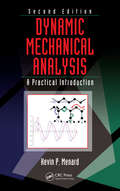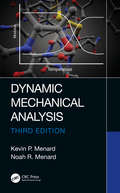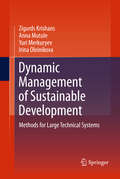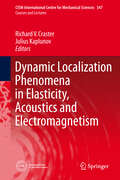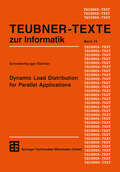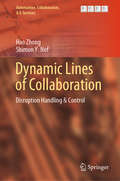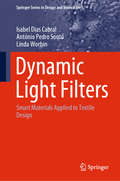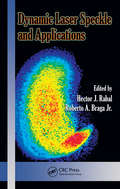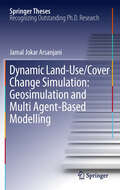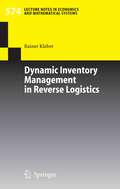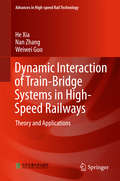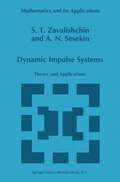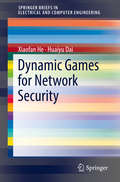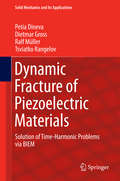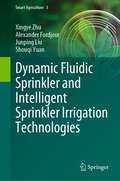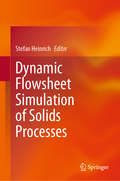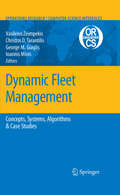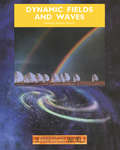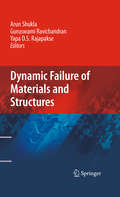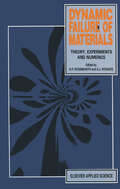- Table View
- List View
Dynamic Mechanical Analysis: A Practical Introduction, Second Edition
by Kevin P. MenardDynamic mechanical analysis (DMA) has left the domain of the rheologist and has become a prevalent tool in the analytical laboratory. However, information on the use of this important tool is still scattered among a range of books and articles. Novices in the field have to dig through thermal analysis, rheology, and materials texts just to find the
Dynamic Mechanical Analysis: A Practical Introduction
by Kevin P. Menard Noah MenardDynamic Mechanical Analysis (DMA) is a powerful technique for understanding the viscoelastic properties of materials. It has become a powerful tool for chemists, polymer and material scientists, and engineers. Despite this, it often remains underutilized in the modern laboratory. Because of its high sensitivity to the presence of the glass transition, many users limit it to detecting glass transitions that can’t be seen by differential scanning calorimetry (DSC). This book presents a practical and straightforward approach to understanding how DMA works and what it measures. Starting with the concepts of stress and strain, the text takes the reader through stress–strain, creep, and thermomechanical analysis. DMA is discussed as both the instrument and fixtures as well as the techniques for measuring both thermoplastic and thermosetting behavior. This edition offers expanded chapters on these areas as well as frequency scanning and other application areas. To help the reader grasp the material, study questions have also been added. Endnotes have been expanded and updated. Features Reflects the latest DMA research and technical advances Includes case studies to demonstrate the use of DMA over a range of industrial problems Includes numerous references to help those with limited materials engineering background Demonstrates the power of DMA as a laboratory tool for analysis and testing
Dynamic Mechanical Analysis
by Kevin P. Menard Noah MenardDynamic Mechanical Analysis (DMA) is a powerful technique for understanding the viscoelastic properties of materials. It has become a powerful tool for chemists, polymer and material scientists, and engineers. Despite this, it often remains underutilized in the modern laboratory. Because of its high sensitivity to the presence of the glass transition, many users limit it to detecting glass transitions that can’t be seen by differential scanning calorimetry (DSC). This book presents a practical and straightforward approach to understanding how DMA works and what it measures. Starting with the concepts of stress and strain, the text takes the reader through stress–strain, creep, and thermomechanical analysis. DMA is discussed as both the instrument and fixtures as well as the techniques for measuring both thermoplastic and thermosetting behavior. This edition offers expanded chapters on these areas as well as frequency scanning and other application areas. To help the reader grasp the material, study questions have also been added. Endnotes have been expanded and updated. Features Reflects the latest DMA research and technical advances Includes case studies to demonstrate the use of DMA over a range of industrial problems Includes numerous references to help those with limited materials engineering background Demonstrates the power of DMA as a laboratory tool for analysis and testing
Dynamic Management of Sustainable Development: Methods for Large Technical Systems
by Zigurds Krishans Anna Mutule Yuri Merkuryev Irina OleinikovaDynamic management of systems development is a precondition for the realization of sustainable system development. This approach allows for the usage of systems theory methods that take into consideration the interaction of decisions made over time and space. A characteristic feature of this kind of method is that the process of sophisticated object development over time is examined for optimal decision selection. This requires the application of modelling methods that represent properties of the developing objects, high speed calculation methods for the estimation of technical and economic characteristics, as well as effective optimization methods. Dynamic Management of Sustainable Development presents a concise summary of the authors’ research in the area of dynamic methods analysis of technical systems development. Along with systematic illustration of mathematical methods, considerable attention is drawn to practical realization and applications. Dynamic Management of Sustainable Development will be helpful for scientists involved in the mathematical modelling of large technical systems development and for engineers working in the area of large technical systems planning.
Dynamic Localization Phenomena in Elasticity, Acoustics and Electromagnetism (CISM International Centre for Mechanical Sciences #547)
by Richard V. Craster Julius KaplunovProperties of wave localization play a decisive role both in applications of engineered microstructures and in the detection of cracks and flaws. The papers in this volume give an introduction into a variety of interrelated dynamic localization phenomena occurring in elasticity, acoustics and electromagnetism. In particular, these involve surface and edge waves and also trapped modes localized near defects, shape changes and the edges of elongated waveguides. The effects of layering, prestress, anisotropy, periodic microstructures as well as various multi-field phenomena are addressed with reference to underlying industrial problems. The essential and up-to-date numerical, asymptotic, and analytical techniques are covered as well as relevant continuum theories that are required to make progress in, and understand wave localization and allied effects. A major focus is on a qualitative physical insight into the mechanisms of dynamic localization.
Dynamic Load Distribution for Parallel Applications (Teubner Texte zur Informatik #24)
by Georg StellnerDynamic Lines of Collaboration: Disruption Handling & Control (Automation, Collaboration, & E-Services #6)
by Hao Zhong Shimon Y. NofThis book focuses on the systematic modeling of complex situations characterized by escalating disruptions, and on cycles of dynamic collaboration for the best handling of disruptions. What can we do about disruptive events and their cascading effects? Thanks to the evolution of intelligent technologies for interaction, communication, sharing, and collaboration, cyberspace is a rapidly expanding world. Our systems of machines, software services, and human organizations have become increasingly interdependent, in other words – networked. As a result, disruptions that initially affect only a small part of any network tend to escalate. At the same time, cyber solutions can support first responders and emergency handlers, enhancing their responsiveness and ability to collaborate with one another in controlling disruptions and preventing their escalation. In this book, we are chiefly interested in how effectively these collaborations can be supported and how we can further optimize such support. Solution guidelines for optimizing collaborations are illustrated with examples in various application domains: agricultural robotics, civil cyber-physical infrastructure, visual analytics, manufacturing automation, and supply chains. Open-source simulation tools are also provided to supplement the main content.
Dynamic Light Filters: Smart Materials Applied to Textile Design (Springer Series in Design and Innovation #3)
by Isabel Dias Cabral António Pedro Souto Linda WorbinThis book offers an extensive, interdisciplinary overview of dynamic textiles. Specifically, it discusses new findings and design concepts concerning the integration of smart materials into textile substrates and their corresponding dynamic behavior. Introducing the topic of dynamic color in textiles, it presents experimental procedures to achieve color change and dynamic light transmittance in thermochromic textiles, and examines their thermoresponsive behavior and respective electrical activation. Moreover, it also addresses the topic of dynamic form and reports on the authors’ original findings using shape-memory alloys and geometric morphologies based on origami techniques. Covering innovative smart textiles and important considerations in terms of design variables when developing textiles with dynamic qualities, and providing extensive, practice-oriented insights into the interaction of textiles with light, it is primarily intended for academics, researchers and practitioners developing smart, dynamic and interactive textiles. The sections describing in detail the experimental work aimed at the integration of smart materials in textile substrates also appeal to professionals in the textile industry.
Dynamic Laser Speckle and Applications (Optical Science and Engineering)
by Hector J. Rabal and Roberto A. BragaSpeckle study constitutes a multidisciplinary area with inherent complexities. In order to conquer challenges such as the variability of samples and sensitive measurements, researchers must develop a theoretical and statistical understanding of both biological and non-biological metrology using dynamic speckle laser.Dynamic Laser Speckle and Applications discusses the main methodologies used to analyze biospeckle phenomena with a strong focus on experimentation. After establishing a theoretical background in both speckle and biospeckle, the book presents the main methodologies for statistical and image analysis. It then deals with the concept of frequency decomposition before moving on to a discussion of fuzzy methods to treat dynamic speckle data. The book dedicates two sections to applications, including agricultural approaches. Additional features include photo images of experiments and software to aid in easy start-up of dynamic speckle usage.A systematic approach to new dynamic speckle laser phenomena, this book provides the physical theory and statistical background needed to analyze images formed by laser illumination in biological and non-biological samples.
Dynamic Laser Speckle and Applications (Optical Science and Engineering)
by Hector J. Rabal Roberto A. Braga Jr.Speckle study constitutes a multidisciplinary area with inherent complexities. In order to conquer challenges such as the variability of samples and sensitive measurements, researchers must develop a theoretical and statistical understanding of both biological and non-biological metrology using dynamic speckle laser.Dynamic Laser Speckle and Applications discusses the main methodologies used to analyze biospeckle phenomena with a strong focus on experimentation. After establishing a theoretical background in both speckle and biospeckle, the book presents the main methodologies for statistical and image analysis. It then deals with the concept of frequency decomposition before moving on to a discussion of fuzzy methods to treat dynamic speckle data. The book dedicates two sections to applications, including agricultural approaches. Additional features include photo images of experiments and software to aid in easy start-up of dynamic speckle usage.A systematic approach to new dynamic speckle laser phenomena, this book provides the physical theory and statistical background needed to analyze images formed by laser illumination in biological and non-biological samples.
Dynamic land use/cover change modelling: Geosimulation and multiagent-based modelling (Springer Theses)
by Jamal Jokar ArsanjaniThe thesis is an original and novel contribution to land use/land cover change analysis using methods of geosimulation and agent-based modeling. The author implements several traditional methodologies of land use change by means of remote sensing and GIS techniques. An Agent-Based Model was developed in order to simulate land use change in the Tehran metropolitan area, comparing the outcomes of each particular methodology. All methods are compared, and advantages and disadvantages discussed.
Dynamic Isolation Technologies in Negative Pressure Isolation Wards
by Zhonglin Xu Bin ZhouThis book presents novel design principles and technologies for dynamic isolation based on experimental studies. These approaches have now become the local standard in Beijing and are currently being promoted for use nationwide. Further, the book provides details of measures and guidelines for the design process. Departing from the traditional understanding that isolation wards should be designed with high negative pressure, airtight doors and fresh air, it establishes the basis for designing biological clean rooms, including isolation wards, using a simple and convenient scientific approach. This book is intended for designers, engineers, researchers, hospital management staff and graduate students in heating ventilation air conditioning (HVAC), air cleaning technologies and related areas.
Dynamic Inventory Management in Reverse Logistics (Lecture Notes in Economics and Mathematical Systems #574)
by Rainer KleberThe integration of product recovery into regular production processes enables new opportunities for cost savings. In case of a dynamic planning situation, for instance when dealing with seasonality or the product life cycle, new motives for keeping stock arise. The work aims to identify those motives and to describe their effects by using methods of optimal control theory.
Dynamic Interaction of Train-Bridge Systems in High-Speed Railways: Theory and Applications (Advances in High-speed Rail Technology)
by He Xia Nan Zhang Weiwei GuoThis book presents both the fundamental theory and numerical calculations and field experiments used in a range of practical engineering projects. It not only provides theoretical formulations and various solutions, but also offers concrete methods to extend the life of existing bridge structures and presents a guide to the rational design of new bridges, such as high-speed railway bridges and long-span bridges. Further, it offers a reference resource for solving vehicle–structure dynamic interaction problems in the research on and design of all types of highways, railways and other transport structures.
Dynamic Impulse Systems: Theory and Applications (Mathematics and Its Applications #394)
by S.T. Zavalishchin A.N. SesekinA number of optimization problems of the mechanics of space flight and the motion of walking robots and manipulators, and of quantum physics, eco momics and biology, have an irregular structure: classical variational proce dures do not formally make it possible to find optimal controls that, as we explain, have an impulse character. This and other well-known facts lead to the necessity for constructing dynamical models using the concept of a gener alized function (Schwartz distribution). The problem ofthe systematization of such models is very important. In particular, the problem of the construction of the general form of linear and nonlinear operator equations in distributions is timely. Another problem is related to the proper determination of solutions of equations that have nonlinear operations over generalized functions in their description. It is well-known that "the value of a distribution at a point" has no meaning. As a result the problem to construct the concept of stability for generalized processes arises. Finally, optimization problems for dynamic systems in distributions need finding optimality conditions. This book contains results that we have obtained in the above-mentioned directions. The aim of the book is to provide for electrical and mechanical engineers or mathematicians working in applications, a general and systematic treat ment of dynamic systems based on up-to-date mathematical methods and to demonstrate the power of these methods in solving dynamics of systems and applied control problems.
Dynamic Hyperpolarized Nuclear Magnetic Resonance (Handbook of Modern Biophysics)
by Thomas Jue Dirk MayerThis is the first book in the series to focus on dynamic hyperpolarized nuclear magnetic resonance, a burgeoning topic in biophysics. The volume follows the format and style of the Handbook of Modern Biophysics series and expands on topics already discussed in previous volumes. It builds a theoretical and experimental framework for students and researchers who wish to investigate the biophysics and biomedical application of dynamic hyperpolarized NMR. All contributors are internationally recognized experts, lead the dynamic hyperpolarized NMR field, and have first-hand knowledge of the chapter material. The book covers the following topics: Hyperpolarization by dissolution Dynamic Nuclear Polarization Design considerations for implementing a hyperpolarizer Chemical Shift Imaging with Dynamic Hyperpolarized NMR Signal Sampling Strategies in Dynamic Hyperpolarized NMRKinetic Modeling of Enzymatic Reactions in Analyzing Hyperpolarized NMR DataUsing Hyperpolarized NMR to Understand Biochemistry from Cells to Humans Innovating Metabolic Biomarkers for Hyperpolarized NMR New Insights into Metabolic Regulation from Hyperpolarized 13C MRS/MRI Studies Novel Views on Heart Function from Dynamic Hyperpolarized NMR Insights on Lactate Metabolism in Skeletal Muscle based on 13C Dynamic Nuclear Polarization Studies About the Editors Dirk Mayer is Professor of Diagnostic Radiology and Nuclear Medicine at the University of Maryland and is the Director of Metabolic Imaging. He is a recognized expert on dynamic nuclear polarization (DNP) MRI-based imaging techniques and has optimized acquisition and reconstruction techniques, has constructed kinetic modeling for quantitative analysis, and has developing new probes. Thomas Jue is Professor of Biochemistry and Molecular Medicine at the University of California Davis. He is an internationally recognized expert in developing and applying magnetic resonance techniques to study animal as well as human physiology in vivo. He served as a Chair of the Biophysics Graduate Group Program at UC Davis, where he started to redesign a graduate curriculum that balances physical science/mathematics formalism and biomedical perspective in order to promote interest at the interface of physical science, engineering, mathematics, biology, and medicine. The Handbook of Modern Biophysics represents an aspect of that effort.
Dynamic Games for Network Security (SpringerBriefs in Electrical and Computer Engineering)
by Xiaofan He Huaiyu DaiThe goal of this SpringerBrief is to collect and systematically present the state-of-the-art in this research field and the underlying game-theoretic and learning tools to the broader audience with general network security and engineering backgrounds. Particularly, the exposition of this book begins with a brief introduction of relevant background knowledge in Chapter 1, followed by a review of existing applications of SG in addressing various dynamic network security problems in Chapter 2. A detailed treatment of dynamic security games with information asymmetry is given in Chapters 3–5. Specifically, dynamic security games with extra information that concerns security competitions, where the defender has an informational advantage over the adversary are discussed in Chapter 3. The complementary scenarios where the defender lacks information about the adversary is examined in Chapter 4 through the lens of incomplete information SG. Chapter 5 is devoted to the exploration of how to proactively create information asymmetry for the defender’s benefit.The primary audience for this brief includes network engineers interested in security decision-making in dynamic network security problems. Researchers interested in the state-of-the-art research on stochastic game theory and its applications in network security will be interested in this SpringerBrief as well. Also graduate and undergraduate students interested in obtaining comprehensive information on stochastic game theory and applying it to address relevant research problems can use this SpringerBrief as a study guide. Lastly, concluding remarks and our perspective for future works are presented in Chapter 6.
Dynamic Fracture of Piezoelectric Materials: Solution of Time-Harmonic Problems via BIEM (Solid Mechanics and Its Applications #212)
by Petia Dineva Dietmar Gross Ralf Müller Tsviatko RangelovDynamic Fracture of Piezoelectric Materials focuses on the Boundary Integral Equation Method as an efficient computational tool. The presentation of the theoretical basis of piezoelectricity is followed by sections on fundamental solutions and the numerical realization of the boundary value problems. Two major parts of the book are devoted to the solution of problems in homogeneous and inhomogeneous solids. The book includes contributions on coupled electro-mechanical models, computational methods, its validation and the simulation results, which reveal different effects useful for engineering design and practice. The book is self-contained and well-illustrated, and it serves as a graduate-level textbook or as extra reading material for students and researchers.
Dynamic Fluidic Sprinkler and Intelligent Sprinkler Irrigation Technologies (Smart Agriculture #3)
by Xingye Zhu Alexander Fordjour Junping Liu Shouqi YuanThis book presents a newly designed dynamic fluidic sprinkler (DFS) to improve hydraulic performance of the existing complete fluidic sprinkler (CFS) under low-pressure conditions. Sprinkler irrigation has high prospects for improving water management in crop production. In recent years, low-pressure water-saving has become an important research content in the field of sprinkler irrigation. It introduces the effect of riser height on rotation uniformity and application rate of the dynamic fluidic sprinkler. It also discusses the intelligent sprinkler irrigation technologies for autonomous and remote sensing system. This book will be a useful reference for researchers and professionals in the field of agriculture and irrigation.
Dynamic Flowsheet Simulation of Solids Processes
by Stefan HeinrichThis book presents the latest advances in flowsheet simulation of solids processes, focusing on the dynamic behaviour of systems with interconnected solids processing units, but also covering stationary simulation. The book includes the modelling of solids processing units, for example for comminution, sifting and particle formulation and also for reaction systems. Furthermore, it examines new approaches for the description of solids and their property distributions and for the mathematical treatment of flowsheets with multivariate population balances.
Dynamic Fleet Management: Concepts, Systems, Algorithms & Case Studies (Operations Research/Computer Science Interfaces Series #38)
by Vasileios S. Zeimpekis Christos D. Tarantilis George M. Giaglis Ioannis E. MinisThis book focuses on real time management of distribution systems, integrating the latest results in system design, algorithm development and system implementation to capture the state-of-the art research and application trends. The book important topics such as goods dispatching, couriers, rescue and repair services, taxi cab services, and more. The book includes real-life case studies that describe the solution to actual distribution problems by combining systemic and algorithmic approaches.
Dynamic Fields and Waves
by A. NortonThis book explores the use of waves on strings and sound waves to illustrate the behaviour of waves. It shows how Albert Einstein overturned Newtonian physics and predicted startling new effects such as time dilation and length contraction for objects travelling at close to the speed of light.
Dynamic Fields and Waves
by A. NortonThis book explores the use of waves on strings and sound waves to illustrate the behaviour of waves. It shows how Albert Einstein overturned Newtonian physics and predicted startling new effects such as time dilation and length contraction for objects travelling at close to the speed of light.
Dynamic Failure of Materials and Structures
by Arun Shukla Yapa D.S. Rajapakse Guruswami RavichandranDynamic Failure of Materials and Structures discusses the topic of dynamic loadings and their effect on material and structural failure. Since dynamic loading problems are very difficult as compared to their static counterpart, very little information is currently available about dynamic behavior of materials and structures. Topics covered include the response of both metallic as well as polymeric composite materials to blast loading and shock loadings, impact loadings and failure of novel materials under more controlled dynamic loads. These include response of soft materials that are important in practical use but have very limited information available on their dynamic response. Dynamic fragmentation, which has re-emerged in recent years has also been included. Both experimental as well as numerical aspects of material and structural response to dynamic loads are discussed. Written by several key experts in the field, Dynamic Failure of Materials and Structures will appeal to graduate students and researchers studying dynamic loadings within mechanical and civil engineering, as well as in physics and materials science.
Dynamic Failure of Materials: Theory, Experiments and Numerics
by H. P. Rossmanith Ares J. RosakisThe rapid pace of current developments in the theoretical, analytical, numerical and experimental fields of dynamic failure of materials called for an international seminar of workshop style aimed at improving the finding and understanding of solutions to the basic physical processes involved in dynamic failure. The Vienna Seminar DFM-l was held at the Technical University Vienna in the historic administration building in the city center under the auspices of the university. More than 30 international experts from all over the world followed the invitation to participate at this seminar. High in the list of priorities was the common desire for ample time for discussions after each technical presenta tion, a fact and a chance frequently made overextensive use of during the seminar. Thus, opportunity was given to the seminar participants to present and expose ideas and results of their original research work, either terminated, ongoing, proposed or conceived and intended, to an international forum of experts for critical discussions, evaluation and appraisal. The technical program included dynamic failure of polymers and steel, numerical modelling of fracture processes, experimental techniques and analytical/numerical investigation of crack/wave interaction problems. The scope of the contributions stretched from implementation of advanced mathematical techniques in the theoretical developments to most direct applications in various fields of engineering practice. Papers published in this volume represent revised, updated and expanded versions of the seminar contributions.
